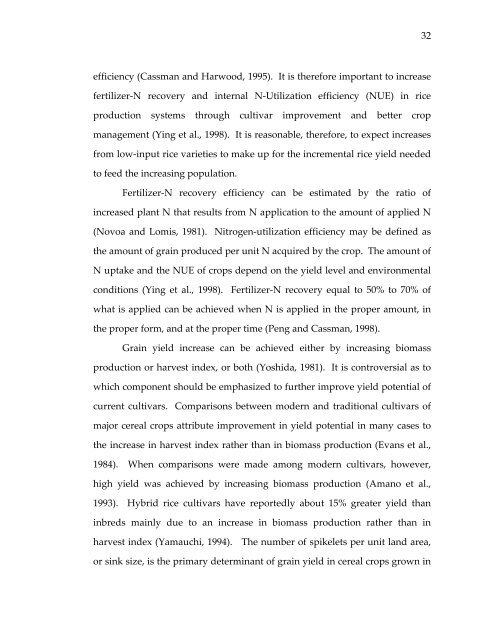Management of rice production systems to increase productivity
Management of rice production systems to increase productivity
Management of rice production systems to increase productivity
You also want an ePaper? Increase the reach of your titles
YUMPU automatically turns print PDFs into web optimized ePapers that Google loves.
efficiency (Cassman and Harwood, 1995). It is therefore important <strong>to</strong> <strong>increase</strong><br />
fertilizer‐N recovery and internal N‐Utilization efficiency (NUE) in <strong>rice</strong><br />
<strong>production</strong> <strong>systems</strong> through cultivar improvement and better crop<br />
management (Ying et al., 1998). It is reasonable, therefore, <strong>to</strong> expect <strong>increase</strong>s<br />
from low‐input <strong>rice</strong> varieties <strong>to</strong> make up for the incremental <strong>rice</strong> yield needed<br />
<strong>to</strong> feed the increasing population.<br />
Fertilizer‐N recovery efficiency can be estimated by the ratio <strong>of</strong><br />
<strong>increase</strong>d plant N that results from N application <strong>to</strong> the amount <strong>of</strong> applied N<br />
(Novoa and Lomis, 1981). Nitrogen‐utilization efficiency may be defined as<br />
the amount <strong>of</strong> grain produced per unit N acquired by the crop. The amount <strong>of</strong><br />
N uptake and the NUE <strong>of</strong> crops depend on the yield level and environmental<br />
conditions (Ying et al., 1998). Fertilizer‐N recovery equal <strong>to</strong> 50% <strong>to</strong> 70% <strong>of</strong><br />
what is applied can be achieved when N is applied in the proper amount, in<br />
the proper form, and at the proper time (Peng and Cassman, 1998).<br />
Grain yield <strong>increase</strong> can be achieved either by increasing biomass<br />
<strong>production</strong> or harvest index, or both (Yoshida, 1981). It is controversial as <strong>to</strong><br />
which component should be emphasized <strong>to</strong> further improve yield potential <strong>of</strong><br />
current cultivars. Comparisons between modern and traditional cultivars <strong>of</strong><br />
major cereal crops attribute improvement in yield potential in many cases <strong>to</strong><br />
the <strong>increase</strong> in harvest index rather than in biomass <strong>production</strong> (Evans et al.,<br />
1984). When comparisons were made among modern cultivars, however,<br />
high yield was achieved by increasing biomass <strong>production</strong> (Amano et al.,<br />
1993). Hybrid <strong>rice</strong> cultivars have reportedly about 15% greater yield than<br />
inbreds mainly due <strong>to</strong> an <strong>increase</strong> in biomass <strong>production</strong> rather than in<br />
harvest index (Yamauchi, 1994). The number <strong>of</strong> spikelets per unit land area,<br />
or sink size, is the primary determinant <strong>of</strong> grain yield in cereal crops grown in<br />
32
















